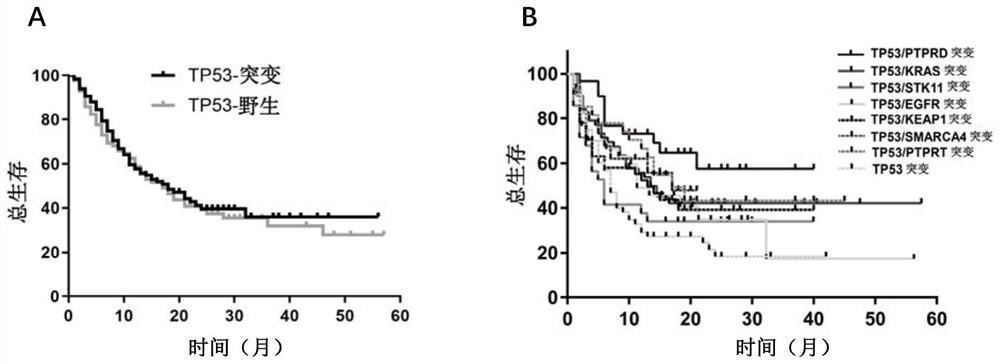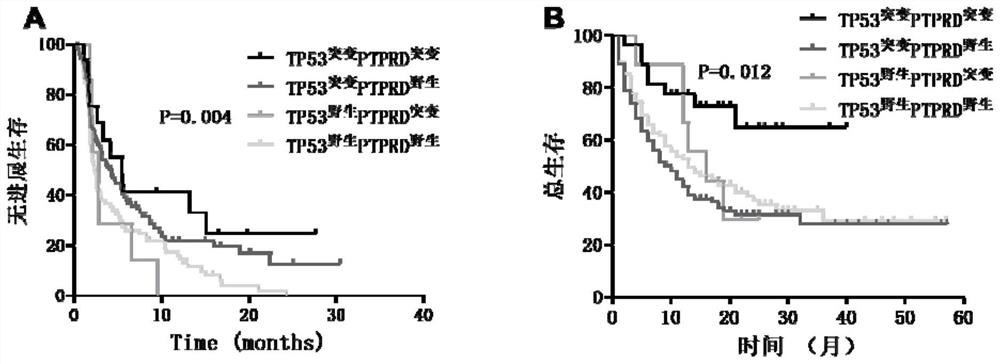Application of PTPRD gene mutation in predicting immunotherapy sensitivity of TP53 mutant lung cancer patient
A mutation-type, patient-oriented technology, applied in measuring devices, microbial measurement/inspection, instruments, etc., can solve problems such as tumor specificity, tumor heterogeneity, and no effective treatment methods, achieve reliable results, and improve detection efficiency effect
- Summary
- Abstract
- Description
- Claims
- Application Information
AI Technical Summary
Problems solved by technology
Method used
Image
Examples
Embodiment 1
[0026] Application of PTPRD gene mutation as a biomarker in predicting sensitivity to immune checkpoint inhibitor therapy in patients with TP53-mutant lung cancer.
[0027] In this example, the DNA of 348 NSCLC patients receiving immunotherapy in MSK Cancer Center was sequenced, and the results were analyzed as follows figure 1 shown. Among them, the mutation rate of TP53 was 62.1% (216 / 348). figure 1 These 216 TP53 mutant patients are KRAS (25.9%), KEAP1 (19.4%), PTPRD (15.7% ), EGFR (14.8%), STK11 (13.4%), PTPRT (13.0%) and SMARCA4 (9.3%).
[0028] Multivariate Cox regression analysis was performed on patients with TP53 mutations to screen independent prognostic genes that were significantly effective in immunotherapy for TP53-mutant lung cancer. STK11, PTPRT and SMARCA4), using the backward:conditional method. The final results showed that only PTPRD mutation can be used as an independent predictor for TP53 mutant NSCLC to receive immunotherapy (HR=1.848; P=0.025). The ...
Embodiment 2
[0038] Effect of PTPRD gene mutation on immune microenvironment in patients with TP53 mutant NSCLC
[0039] In order to elucidate the internal factors of the remarkable efficacy of immunotherapy in patients with TP53 / PTPRD double mutations, the present invention analyzes the mutation status of TP53 and PTPRD genes in the TCGA (The CancerGenome Atlas) database of lung cancer through the method of gene set enrichment analysis (GSEA) The effect on the signal pathway of gene enrichment, the results are as follows Figure 4 shown. pass Figure 4 A, 4B shows that TP53 突变 / PTPRD 突变 Double mutant group compared to TP53 突变 / PTPRD 野生 group significantly up-regulated interferon gene stimulator (cGAS-STING) signaling pathway and IFN-β signaling pathway. also, Figure 4 C, 4D can be seen, lung cancer TCGA database analysis shows that TP53 突变 / PTPRD 突变 Compared with other subgroups, the RNA expression of STING1 and its downstream key gene IRF3 was significantly higher in the subgroup...
Embodiment 3
[0046] Embodiment 3PTPRD gene mutation site analysis
[0047] The mutation site of PTPRD gene was analyzed, and the results were as follows: Figure 7 shown. It was found that the variants of PTPRD gene were mainly missense mutations, followed by truncation mutations and whole code mutations. Gene mutation sites are relatively scattered, and there is no obvious hotspot mutation area.
[0048] In conclusion, PTPRD gene mutation can be used as a predictor of sensitivity to immune checkpoint inhibitor therapy in patients with TP53 mutant lung cancer.
PUM
 Login to View More
Login to View More Abstract
Description
Claims
Application Information
 Login to View More
Login to View More - R&D
- Intellectual Property
- Life Sciences
- Materials
- Tech Scout
- Unparalleled Data Quality
- Higher Quality Content
- 60% Fewer Hallucinations
Browse by: Latest US Patents, China's latest patents, Technical Efficacy Thesaurus, Application Domain, Technology Topic, Popular Technical Reports.
© 2025 PatSnap. All rights reserved.Legal|Privacy policy|Modern Slavery Act Transparency Statement|Sitemap|About US| Contact US: help@patsnap.com



